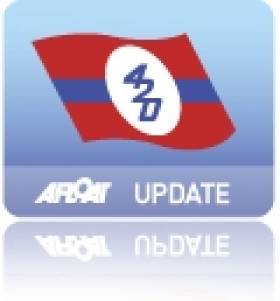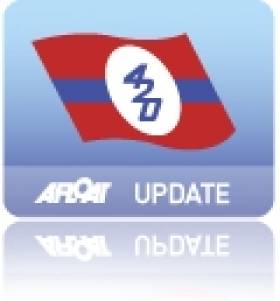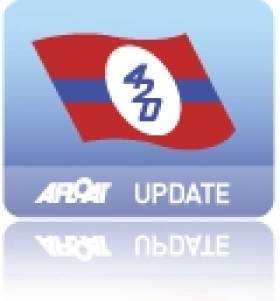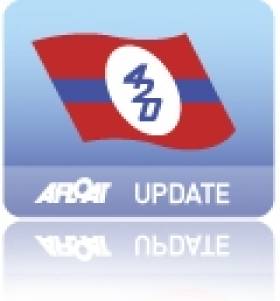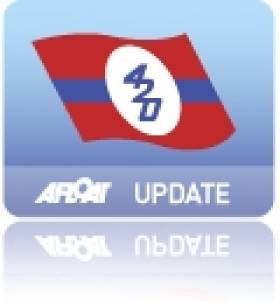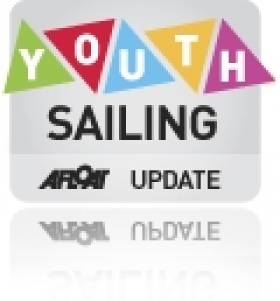Displaying items by tag: 420
420 Irish Champion Brothers in Action at 420 Euros, Pwllheli
#420– Recently crowned Irish champions Harry and David Whitaker are among an Irish team racing at the 420 and 470 Junior European Championships today in Pwllheli, Great Britain. The 420 and 470 Junior European Championships are run together to support the natural transition between the 420 and 470, although will race on two separate course areas.
The host club, Clwb Hwylio Pwllheli Sailing Club, is located in the North Wales holiday resort of Pwllheli, and one of four national sailing academy venues recognized by the Royal Yachting Association. Racing against the backdrop of Snowdon and the Welsh mountains, the racing conditions on the waters of Cardigan Bay are some of the best in the UK, with the area renowned for its weak tidal streams and stable winds.
A total of 272 sailors are competing, with ninety-six teams contesting the 420 Junior Europeans and forty teams lining up for the 470 Junior Europeans, representing a total of 20 nations. In the 420 fleet, teams must be 18 years or younger in the year of the Championship, with crews in the 470 required to be 21 years or younger, with some of the classes' most talented youth teams set to flex their muscles on Cardigan Bay.
420 Junior European Championship
For the 420 fleet, there are numerous familiar faces who raced at the SailFirst ISAF Youth Sailing World Championships and then jumped straight over to the 420 Worlds in Valencia, Spain, and are back on the race track at the 420 Junior Europeans. To ensure quality of racing, entries are limited with a strict quota of seven teams per nation, apart from the host nation who can enter 14 teams.
Amongst the pre-race favourites are Portugal's Diogo Pereira/Pedro Cruz who claimed the bronze medal at the ISAF Youths and followed up with a 6th at the 420 Worlds. But, familiarity with the conditions here is all important, and New Zealand's Taylor Burn/Henry Gibbs have a card up their sleeve after their win at the British 420 National Championships which wrapped up here two days' ago.
Also set to give the fleet a challenge on the race track are the 420 Ladies World Champions, Annabel Cattermole/Bryony Bennett-Lloyd, who took a convincing gold medal in Valencia, fresh from a 12th place at the ISAF Youth Worlds. Bennett-Lloyd then stepped in as a reserve crew at the 470 Worlds last week in La Rochelle.
Another highly experienced pair are Italy's Ilaria Paternoster/Benedetta di Salle who secured the bronze medal at this year's ISAF Youth Worlds, following on from their gold medal in 2012. Also set to be amongst the frontrunners are Spain's reigning 420 National Champions Silvia Mas/Nuria Mira.
The ninety-six boat 420 fleet sail as an open division, with mens, ladies and mixed teams competing against each other. The teams have been split into two fleets of 48 boats each for the six race qualification series which is scheduled to take place from 16-18 August, after which they will advance to gold and silver fleets for the 6 race final series from 20-22 August, with a reserve day in between. Racing is scheduled to get underway at 1400 hours on Friday 16 August 2013.
The predominant weather across the period of the Championship is forecast to be fairly breezy, but with lighter conditions of around 8-11 knots for Friday's opening day of racing. Saturday looks set to be a blower, with winds of 21-23 knots and gusts up to 34 knots forecast.
The 420 and 470 Junior European Championships were formally opened on Thursday evening with the Opening Ceremony celebrations to the resounding accompaniment of a traditional Welsh Brass Band. Speeches were made by Bob Lowe on behalf of the host venue Pwllheli Sailing Club and Nino Shmueli on behalf of the International 420 and 470 Class Associations. The 2013 420 Ladies World Champions, Annabel Cattermole/Bryony Bennett-Lloyd from Great Britain, made the Sailors' Oath on behalf of all competing teams.
Irish 420 Title Goes to Royal Cork's Whittaker Brothers
#420 – Two races sailed outside Roches Point in light winds saw a conclusion after nine races and one discard to the 2013 420 dinghy National Championships at Royal Cork Yacht Club this evening. Results available to download below.
The wind died completely at the end of the last race as brothers Harry and David Whitaker (RCYC) took first place overall, with Robert Dickson and Sean Waddilove (HYC and SSC) second and Ewan McMahon and Colin O'Sullivan (HYC / MYC) third. 16 boats competed.
Dickson and Waddilove, ISAF Youth Worlds reps in Cyprus, put up the main challenge and had more first places than the Whitakers but had to settle for second overall to the ever consistent brothers.
Lizzy and Cara McDowell (MYC) were first girls in 6th place overall. Second girls were Cliodhna no Shuilleabhain and Jil McGinley (KYC /RCYC) with Kate and Alanna Lyttle (RSGYC) in third place
For many of the leading sailors this event set them up nicely for their next challenge as no sooner were the boats back in the dinghy park on Sunday than they were being loaded onto a big trailer and off to Pwllheli in North Wales for the 420 Junior Europeans which start later this week.
#420– Royal Cork Yacht Club hosts the 2013 Volvo 420 National Championships from the 9th to the 11th of August with three races being planned on each day off Roches Point, Cork Harbour. The nationals follows some intense international activity in Valencia, Spain where Howth pair Robert Dickson and Sean Waddilove were top Irish, and third U16 crew.
Preceding the Cork Harbour championships, former Olympic 470 crew man and 420 coach Ross Killian from the National Yacht Club will take a coaching session on 7th and 8th August with a total of three coaches on the water. The cost for the session is €100 per boat with food being provided on the Wednesday night.
Last year, the nationals were won in impressive style by the young Royal Cork YC pairing of Patrick Crosbie and Grattan Roberts who took the gun in five of the 9 races and never placed lower than 3rd.
Howth 420 Dinghy Pair End Worlds Campaign in Top Half
#420 – Ireland will have to be satisfied with a top half result at the 2013 420 World and Ladies World Championships in Valencia, Spain which ended yesterday. Best of the five boat Irish crews in the 110–boat fleet were Howth's Robert Dickson and Sean Waddilove in 55th, just not high enough to make the gold fleet but also the third placed U16 crew. Harry and David Whittaker were 76th (and took second overall in the bronze fleet; Adam Hyland and Bill Staunton 85th, Jack lee and Ciaran Jordan 109th and Ewan McMahon and Colm O'Sullivan 110th.
The highlight yesterday was the Whitaker brothers third place.
Irish team skills are honed now for the 420 Junior European championships in a fortnight's time, on home waters, on the Irish Sea at Pwllheli in North Wales.
There was a thrilling final day of racing at the championships in Valenica where strong thermals produced a magic event.
Spain's Xavier Antich/Pedro Terrones winning the 420 World Championship title and Great Britain's Annabel Cattermole/Bryony Bennett-Lloyd sealing victory in the 420 Ladies World Championship in Valencia, Spain.
The day was intense and exciting as teams' patience and nerves were tested waiting for the breeze to fill in. Postponed ashore racing eventually got underway at 1500 hours, with the building breeze reaching around 12 knots.
420 OPEN
The surprise of the day was undoubtedly the victory in the 420 Open fleet by Xavier Antich/Pedro Terrones, who managed to close the gap separating them from the first placed team going into the day and recent ISAF Youth World Champions Tiago Britto/Kneipp Andrei from Brazil.
The Spanish pair literally snatched victory from Brito/Kneipp who had led the series until race 11, by sailing the race of their lives, with the Brazilians back in 28th.
Britto/Kneipp have excelled here in Valencia, heading up the 420 Open fleet after each day's racing, and seemed certain to seal gold. But the World Championship crown slipped away from them after two days of mixed results gave them no margin to put another foot wrong in today's two races. And that they did, scoring a 12, 28, compared to the 15,5 scoreline of the Spanish.
A delighted Antich said, "We are very proud to be champions of the world because we have spent many years working to get it. The consistency has helped us to be ahead always."
"It was a pretty tough race but we worked all the way and now we get the result," added Terrones.
Sebastien Simon/Pierre Rhimbault were also in the battle for gold, but a bit of a shocker for the pair gave them their worst two races of the series to finish in third and be awarded bronze medals.
Italy's Matteo Pilati/Michele Cecchin won the William Sanchez Trophy for the best under-16 crew after their 8th overall on the leaderboard.
The Huck Scott Memorial Trophy, awarded to the youngest crew at the 420 Worlds, was presented to the Austrian team of George Steinhaler/Patrick Christa.
Having had to wait for the breeze to fill in, the time limit cut-off meant it was not possible to hold the final race 12 for the silver and bronze fleets. At the Closing Ceremony, the top finishers in each fleet, Hippolite Macheti/Sidoine Dantes (FRA) and Taylor Balogh/Samuel Lee (NZL) respectively, were presented with trophies.
420 Open – Leaderboard Top 10
1. Xavier Antich/Pedro Terrones (ESP) – 83 pts
2. Tiago Brito/Andrei Kneipp (BRA) – 86 pts
3. Sebastien Simon/Pierre Rhimbault (FRA) – 92 pts
4. Swann Hayewski/Alexis Thomas (FRA) – 93 pts
5. José María Ruiz/Fernando Davila (ESP) – 94 pts
6. Diogo Pereira/Pedro Cruz (POR) – 97 pts
7. Manuel Cunha/Joao Cunha (POR) – 98 pts
8. Matteo Pilati/Michele Cecchin (ITA) – 105 pts
9. Wade Waddel/Henry Fernberger (USA) – 107 pts
10. Keiju Okada/Yuta Miyaguchi (JPN) – 110 pts
420 LADIES
Great Britain's Annabel Cattermole/Bryony Bennett-Lloyd exceeded their expectations and secured gold. It was only after the qualifying stage of the Championship that the pair became realistic contenders, as their consistent scoreline stood out, with only two finishes outside the top 10.
"It feels incredible, I don't think it has quite sunk in yet but I think it will get there eventually – it just doesn't feel quite real that we have actually won and are World Champions," expressed Cattermole.
"Going into the final race of the regatta we knew we needed a top ten to win and a top 20 to finish on the podium, so we entered the race like we have done all the other races, try to sail like we have been doing and do what we have been doing. We got a clear start which was good and had a good run up the first beat with lots of clean air with options to do what we wanted and to sail as quick as we wanted," explained Cattermole.
The British pair also won the John Merricks Trophy for the best under-18 crew.
Singapore's Kimberly Lim/Savannah Siew secured the silver medal and rounded out their Championship bid in style by winning the final race. A great outcome for this pair, who finished in fourth at last year's Ladies Worlds.
Bronze goes to Italy's Sara Scotto di Vettimo/Vittoria Barbiero, who sailed a very consistent series with 5 top three results.
The William Sanchez Trophy for the best under-16 crew was presented to Spain's Manuela Huidobro/Lucia Bustrillo. Silvia Mas/Nuria Miró, Spain's reigning National 420 Champions, won the 420 Ladies silver fleet.
420 Ladies – Leaderboard Top 10
1. Annabel Cattermole/ Bryony Bennett -Lloyd (GBR) – 52 pts
2. Kimberly Lim/Savannah Siew (SIN) – 69 pts
3. Sara Scotto Di Vettimo/Vittoria Barbiero (ITA) – 74 pts
4. Nadja Horwitz/Carmina Malsch (CHI) – 76 pts
5. Carlotta Omari/Francesca Russo Cirillo (ITA) – 79 pts
6. Ilaria Paternnoster/Di Salle Benedetta (ITA) – 89 pts
7. Paula Barceló/Margarita Alba (ESP) – 101 pts
8. Alkaterina Tavolauri/Foteini Koutsoumpou (GRE) – 111 pts
9. Zeynep Yentur/Deniz Gokmeral (TUR) – 121 pts
10. Carmen Davila/Julia Davila (ESP) – 123 pts
Howth Duo Seeking Gold Fleet at 420 Worlds
#420Worlds – Two more races today will decide if four Irish boats racing at the 2013 420 World and Ladies World Championships will advance to the gold, silver and bronze fleets. Robert Dickson and Sean Waddilove, the recent ISAF youth representatives in Cyprus, are faring the best of four Irish boats after day two but to secure gold fleet participation the pair will need to have a strong final qualification round today. They are currently placed 69th out of 110 in Valencia, Spain.
Howth Dinghy Duo Best of Irish at 420 Worlds, Valencia
#420 – Howth youth dinghy sailors Robert Dickson and Sean Waddilove, the recent ISAF youth representatives in Cyprus, are faring the best of four Irish boats after day one of the 420 World and Ladies World Championships in Valencia, Spain this week. A light breeze of around 7 knots greeted teams for day 1 of racing at the 2013 420 World Championships, as racing got started under a clear blue sky and dazzling sun. By the time race 2 was underway, the wind had increased to around 10-12 knots.
The 110 teams in the 420 Open fleet have been seeded into yellow, blue and red fleets, with the 87 Ladies teams seeded into yellow and blue for the six races of the three day qualification series. Teams will be reseeded after each of the three qualification days, before advancing to the final gold, silver and bronze fleets for the 420 Open and gold, silver for the 420 Ladies for another six races over the three day final series.
420 Open - Leaderboard Top 5
1. Gianmaria Caiconti / Edoardo Portoraro, ITA, 3 points
2. Tiago Brito / Andrei Kneipp, BRA, 3
3. Santiago Mas / David Mas, ESP, 5
4. Ibuki Koizumi / Tsubasa Arioka, JPN, 7
5. Jose María Ruiz / Fernando Davila (ESP, 9
In the 420 Ladies Championiship, Carlotta Omari / Francesca Russo Cirillo of Italy were the team of the opening day, knocking out two race wins with what looked like relative ease in the blue fleet.
Full results here
Schull Duo Best of Irish 420 Sailors in France
#420 – Conditions that brought fine weather to Ireland produced thick sea fog in Brittany, spoiling the French 420 National Championships at Pleneuf Val-Andre on the north Breton coast, attended by ten Irish crews.
Of the young Irish sailors at the event, that concluded yesterday, it appears Maryne Poppet and Mark Hassett from Schull were top boat in 37th place from 85 starters. Full results downloadable below.
Six races were completed in total, four on the last day.
Fog Lifts at 420 French Nationals, McDowell's Top Irish
#420 – Fog lifted yesterday afternoon and two races were sailed at the 420 French national championships in Brittany, the first of the event that lost its first two days of racing due to persistent fog. Overall results were not published but Lizzy and Cara McDowell lead the Irish contingent with a 14 and a 22 scored. Racing is scheduled to end today.
Irish Sailors Fogbound at 420 French Event
#420 – In Day 2 of scheduled racing at the 420 dinghy French national championships it has been a case of Fog 2, sailors 0. Sailors, including an Irish team, didn't even launch.
#youthsailing – In Crozon, south west Brittany, two races were completed in very light wind at the Optimist Summer Cup, attended by 15 Irish sailors including the Irish International Development team.
In Pleneuf Val-Andre on the north Breton coast, day one of the 420 national championships saw racing cancelled due to heavy fog. 10 Irish sailors are in Pleneuf for the event.




























